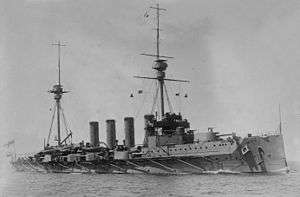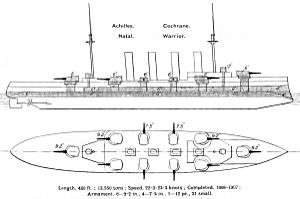Action of 16 March 1917
The Action of 16 March 1917 was a naval engagement in which the British armed boarding steamer Dundee and the Warrior-class armoured cruiser HMS Achilles fought and sank the German auxiliary cruiser SMS Leopard, which sank with all 319 hands and the six men of a British boarding party.
| Action of 16 March 1917 | |||||||
|---|---|---|---|---|---|---|---|
| Part of World War I | |||||||
 Achilles | |||||||
| |||||||
| Belligerents | |||||||
|
|
| ||||||
| Commanders and leaders | |||||||
|
|
| ||||||
| Strength | |||||||
|
1 armoured cruiser 1 AB steamer | 1 auxiliary cruiser | ||||||
| Casualties and losses | |||||||
|
6 killed |
1 auxiliary cruiser sunk 319 killed | ||||||
 The battle location in the Nowegian Sea | |||||||
Action

After leaving port in March disguised as the Norwegian freighter Rena Norge, Leopard (Captain Hans von Laffert) set sail on its mission to disrupt Allied commerce. On 17 March, the cruiser HMS Achilles stopped Leopard in the Atlantic, about midway between Iceland and Norway and ordered her to proceed to the boarding vessel Dundee (Captain Selwyn Day) for inspection. Out-gunned, Laffert had no option but to proceed to the boarding vessel.[1]
Day dispatched a launch containing a boarding party of an officer and five men to investigate the apparent merchant vessel. Laffert realised that he was about to be discovered, detained the party, and after about an hour fired two torpedoes at Dundee. Dundee manoeuvred out of the way just in time and the torpedoes missed by 20 yards (18 m). Day ordered his gun crews to open fire and shells hit Leopard from the stern at such close range that every shot was a hit, smoke and steam rising from Leopard. Leopard turned to starboard but Dundee turned to port to avoid a broadside. By this time Leopard had been hit forty times.[2]
Achilles was 4 nautical miles (4.6 mi) to the east-north-east and opened fire on the raider about five minutes after Dundee had commenced firing. As Dundee avoided another broadside, Leopard's gunners fired wild as she sailed straight for Achilles to avoid the fall of shot. Leopard continued to return fire for about an hour more, while shells from Achilles's heavy guns caused explosions and jets of flame and smoke. Leopard began to sink but the crew continued to fire; at 4:30 p.m. Leopard sank with all 319 hands. Damage to the British vessels was light and the only casualties were the six members of the boarding party members on Leopard when it sank.[3]
Footnotes
- Newbolt 2003, pp. 192–193.
- Newbolt 2003, pp. 193–194.
- Newbolt 2003, pp. 194–195.
References
- Cranwell, J. P. (1970). Spoilers of the Sea: Wartime Raiders in the Age of Steam. Books for Libraries Press. p. 302. ISBN 9780836915631.
- Enright, P. J. "Yarrowdale - Ships - Count Dohna and His SeaGull". smsmoewe.com. Archived from the original on 3 March 2016. Retrieved 12 November 2015.
- Newbolt, H. (2003) [1928]. Naval Operations. History of the Great War Based on Official Documents. IV (Naval & Military Press ed.). London: Longmans. ISBN 1-84342-492-4. Retrieved 18 January 2016.